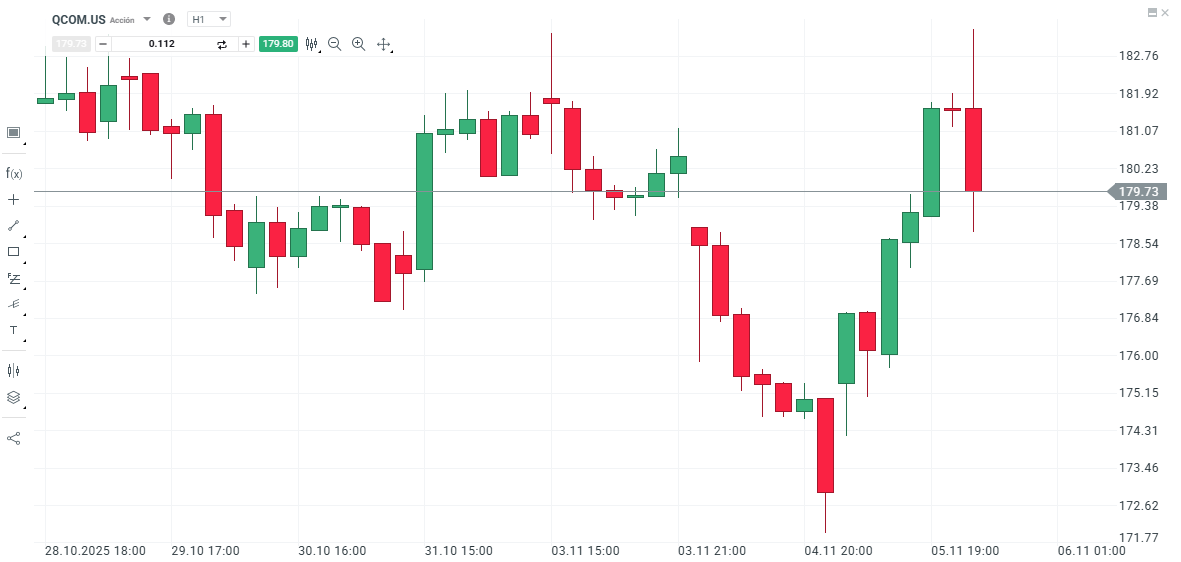- Qualcomm increases its revenue
- Are Qualcomm's results good?
- Qualcomm increases its revenue
- Are Qualcomm's results good?
Qualcomm reported a stronger-than-expected close to fiscal 2025, beating consensus across all key metrics and offering an upbeat forecast for its next quarter. Yet, despite the robust operational performance, shares slipped around 2.3% in after-hours trading as investors digested a one-time U.S. tax hit and questioned whether the company’s recent rally had run ahead of fundamentals.
Financial Performance Overview
-
Adjusted revenue: $11.27 billion, up 10% year-over-year (consensus: $10.77 billion)
-
Adjusted EPS: $3.00 per share, up from $2.69 a year ago (consensus: $2.88)
-
Adjusted operating income: $3.81 billion, +8.6% y/y (consensus: $3.65 billion)
-
QCT (chip segment) revenue: $9.82 billion, +13% y/y (consensus: $9.35 billion)
-
QTL (licensing) revenue: $1.41 billion, -7.4% y/y (consensus: $1.36 billion)
Growth was primarily driven by the handset division, which delivered $6.96 billion in revenue (+14%), reflecting strong Android and flagship device launches. The automotive business rose 17% to $1.05 billion, while the IoT segment expanded by 7.4% to $1.81 billion.
Full-year results also revealed 18% growth in QCT non-Apple revenues and 27% growth in combined automotive and IoT sales—key proof points for Qualcomm’s strategic diversification beyond smartphones.
Forecast and Tax Impact
For fiscal Q1 2026, Qualcomm guided:
-
Revenue: $11.8 billion – $12.6 billion (consensus: $11.59 billion)
-
Adjusted EPS: $3.30 – $3.50 (consensus: $3.26)
-
QCT revenue: $10.3 billion – $10.9 billion (consensus: $10.1 billion)
-
QTL revenue: $1.4 billion – $1.6 billion
Despite the optimistic revenue and profit outlook, Qualcomm booked a $5.7 billion writedown linked to a U.S. tax law adjustment, resulting in a net loss of $3.12 billion for the quarter. The company expects that adopting the Alternative Minimum Tax (AMT) framework will stabilize its long-term effective tax rate around 13–14%, below what it would have faced otherwise.
Business Momentum and Strategic Focus
CEO Cristiano Amon emphasized Qualcomm’s ongoing transformation into a diversified semiconductor player, citing strong traction in automotive chips, IoT growth, and new momentum in AI and PC processors.
The firm recently unveiled its AI 100 Ultra platform and next-generation Snapdragon chips, aiming to expand AI computing into data centers and personal devices. The company's first major data center AI chip is scheduled for 2026 shipments, with Humain, a Saudi-backed AI startup, as the launch customer.
Amon also reaffirmed optimism over Qualcomm’s automated driving stack and new design wins in connected vehicles — two long-term growth catalysts meant to buffer the gradual loss of Apple’s modem business as the iPhone maker transitions to internal components.
Competitive Landscape and Macro Context
Qualcomm remains deeply tied to mobile devices, but its diversification into automotive, IoT, and AI computing is gradually balancing the cyclical handset exposure. The competitive environment is shifting, particularly with Apple designing its own modems and rival MediaTek pushing into premium-tier Android devices.
The company also stands to gain from a geopolitical thaw after President Donald Trump and President Xi Jinping agreed to terminate antitrust investigations—potentially reducing regulatory and supply-chain pressure on U.S.–China chip trade.
Conclusions
The quarter is “solid upside,” citing across-the-board beats and an improving product mix. However, operating margins were slightly lighter than expected, and the market’s tepid reaction reflects inflated expectations after a pre-earnings stock run-up.
From a strategic perspective, Qualcomm’s quarter shows the company successfully navigating transition. Operationally, the core chip business continues to outperform peers in both consumer and industrial segments. The tax adjustment masks what was otherwise a structurally strong quarter, confirming execution strength under difficult macro and competitive conditions.
However, investor expectations have become difficult to meet in the current semiconductor rally. Much as seen with AMD and Micron, markets now demand demonstrable AI-driven profit acceleration, not just incremental improvement. Qualcomm’s deep consumer orientation and more modest AI exposure may have limited excitement relative to firms like Nvidia or Arm.
That said, the pathway toward diversification — through automotive, edge AI, and PC markets — remains intact and credible. The next 12–18 months will test Qualcomm’s ability to capitalize on this positioning, particularly as it launches AI PC chips set to rival Apple’s M-series and AMD’s new AI-accelerated lines.
 Source: xStation5
Source: xStation5
DE40: Regulatory and diplomatic escalations amid holidays
Novo Nordisk - There Were Risks, Now It's Time for Opportunities.
US OPEN: Renewed optimism at the beginning of the week
Nvidia: Potential H200 Shipments to China in the Spotlight
This content has been created by XTB S.A. This service is provided by XTB S.A., with its registered office in Warsaw, at Prosta 67, 00-838 Warsaw, Poland, entered in the register of entrepreneurs of the National Court Register (Krajowy Rejestr Sądowy) conducted by District Court for the Capital City of Warsaw, XII Commercial Division of the National Court Register under KRS number 0000217580, REGON number 015803782 and Tax Identification Number (NIP) 527-24-43-955, with the fully paid up share capital in the amount of PLN 5.869.181,75. XTB S.A. conducts brokerage activities on the basis of the license granted by Polish Securities and Exchange Commission on 8th November 2005 No. DDM-M-4021-57-1/2005 and is supervised by Polish Supervision Authority.


